Panel studies high cost of college texts
- Share via
A federal advisory panel studying the high cost of college texts was offered a simple suggestion Monday for keeping down expenses: Don’t use so many books.
Or, at least, not books in the conventional sense. The idea is to prod professors to develop more courses that take advantage of articles, lecture notes, study guides and other materials available for free on the Internet.
That suggestion, and several others, were aired during a 3 1/2-hour meeting in Santa Clarita, where the Advisory Committee on Student Financial Assistance heard from college administrators, textbook publishers and other higher education leaders and advocates.
The meeting -- the second of three field hearings the panel will hold around the country before it delivers a congressionally requested report in May -- didn’t produce any consensus solutions. And neither did it answer a question that seemed to be a subtext of the proceedings: Who is to blame for textbooks that often cost more than $100?
Those costs have increasingly drawn attention from state and federal lawmakers over the last three years, prompted in part by student activists. The effort gained support in 2005 when the U.S. Government Accountability Office reported that college textbook prices have climbed at twice the rate of inflation over the last two decades.
Students activists and their allies have largely blamed publishers for the phenomenon. They have pointed to such practices as issuing unnecessary new editions and bundling texts with additional, often unwanted, instructional materials such as CD-ROMs.
Many of the participants in Monday’s session, held at College of the Canyons, agreed that those practices are part of the problem. Among the solutions proposed were a variety of measures already in place at some campuses, including providing students with the option of renting books, as well as encouraging professors to change their required textbooks less frequently so that students have more opportunity to buy cheaper used volumes.
In addition, some officials suggested stepped-up funding of scholarships and other financial aid designed to help pay for books.
But probably the most dramatic cost-cutting proposal came from leaders of the Foothill-De Anza Community College District, a two-campus system in the Silicon Valley. That district has adopted a policy to encourage the use of public domain materials on the Internet. It reflects a broader movement involving materials that can be used for nonprofit educational purposes for free. Academics commonly call them open educational resources. The movement has been backed by such universities as MIT, Carnegie Mellon and Yale, along with the Hewlett Foundation. “We want to change the question from ‘How do you help students buy textbooks?’ to ‘How do we enhance student learning and student success?’ ” said Hal Plotkin, board of trustees president of Foothill-De Anza.
Plotkin brushed aside concerns that the spread of free learning materials could eventually undermine the ability of publishers and professors to bring out new, needed texts. “There’s a future for enlightened publishers, but it’s not a future of selling $150 algebra books,” he said. “That’s something we have to get away from.”
Executives of publishing companies agreed that there might be a place for free materials that replace basic texts.
Sean Wakely, president of Belmont-based Thomson Arts and Sciences, a unit of one of the nation’s largest college textbook publishers, said he could foresee “a hybrid situation” in which students would rely both on public domain materials but also instructional videos, case studies and online resources that they would buy. “We have to figure out a business model that would work,” he said.
As for settling on who bears the blame for high textbook costs, speakers variously pointed to publishers, professors who order and write the books, and college bookstores.
“We’re simply going to have to disagree,” said Wakely, when asked pointedly by a faculty leader why textbook costs have risen far faster than inflation.
Wakely said publishers bear heavy expenses when bringing out new books, as well as for developing sophisticated online instructional materials that do such things as illustrate concepts in physics. “That has to be paid for somehow,” Wakely said.
Congressional leaders, while drawing attention to the issue through the advisory panel’s study, are not expected to call for legislation to remedy the problems.
States such as California, however, may be poised to take further steps. Steve D. Boilard, head of the higher education unit of the legislative analyst’s office, cited proposals introduced this year to, among other things, increase financial aid stipends and require publishers to disclose their wholesale prices and the amount of time they intend to keep their products on the market.
stuart.silverstein@latimes.com
More to Read
Sign up for Essential California
The most important California stories and recommendations in your inbox every morning.
You may occasionally receive promotional content from the Los Angeles Times.










